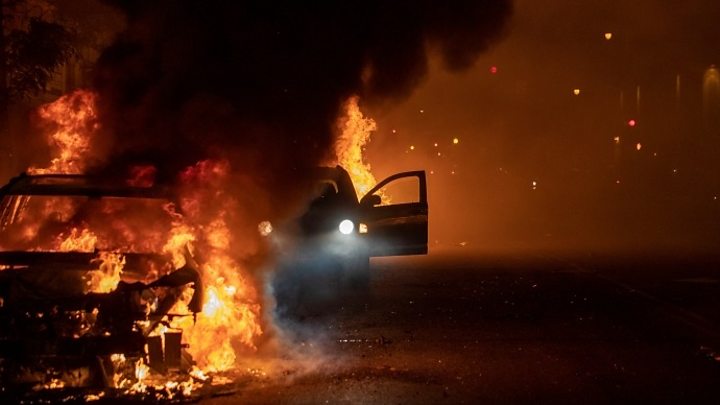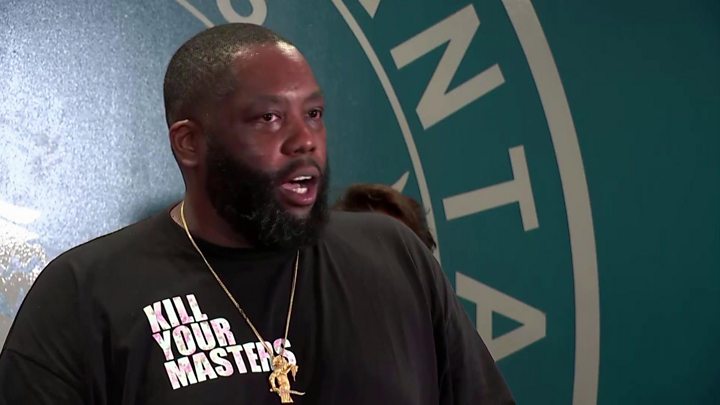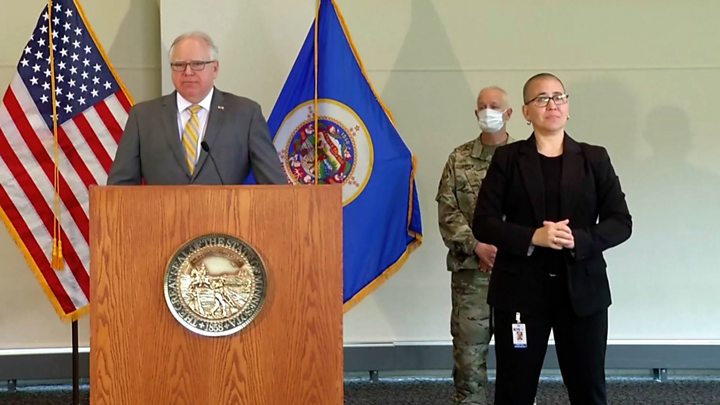
Media playback is unsupported on your device
Curfews have been ordered in cities across the US to try to stem unrest sparked by the death of a black man in police custody.
Largely peaceful protests later turned violent in many areas, with cars and buildings set alight and riot police using tear gas and rubber bullets.
President Donald Trump urged "healing" over the death of George Floyd but said he could not allow mobs to dominate.
An ex-policeman has been charged with murdering Mr Floyd, 46, in Minneapolis.
Derek Chauvin, 44 and white, is due to appear in court on Monday.
In video footage, Mr Chauvin can be seen kneeling on Mr Floyd's neck for several minutes on Monday. Mr Floyd repeatedly says that he is unable to breathe.
Three other officers present at the time have also since been sacked.
The Floyd case has reignited US anger over police killings of black Americans. It follows the high-profile cases of Michael Brown in Ferguson, Eric Garner in New York and others that have driven the Black Lives Matter movement.
But for many it also reflects years of frustration over socioeconomic inequality and segregation, not least in Minneapolis itself.
What's the latest on the protests?
Large demonstrations have taken place in at least 30 cities across the US.
Police in Los Angeles fired rubber bullets as they tried to disperse crowds who threw bottles and set fire to their squad cars. Images later showed people standing on police vehicles that had been damaged. After dark, overhead footage showed numerous fires burning.
In New York, video showed a police car driving into a crowd of protesters. Mayor Bill de Blasio said the situation was not started by the officers, but Congress Representative Alexandria Ocasio-Cortez said his comments were unacceptable and he should not be making excuses for the officers.
In Chicago, protesters threw stones at riot officers, who responded by launching tear gas canisters. Several people were arrested.
In Atlanta, where buildings were vandalised on Friday, a curfew and state of emergency was declared for some areas to protect people and property.
One city that has seen less violence is where George Floyd died. Some 700 National Guard officers are aiding police in Minneapolis and they acted quickly to enforce the curfew imposed there. The Star Tribune said the action had so far headed off the unrest of the previous night.
The National Guard is a reserve military force that can be called on by the US president or state governors to intervene in domestic emergencies.
For the second day running, a large crowd taunted National Guard officers outside the White House in Washington, DC.
In Philadelphia, also under curfew, 13 police officers were hurt and at least 35 arrests made as stores were looted, police cars torched and buildings defaced.
Overnight curfews have also been declared in Philadelphia, Portland and Louisville, among other cities, although many were simply ignored.
What has the president said?
On Saturday evening, Mr Trump said that Mr Floyd's death had "filled Americans with horror, anger and grief".
"I stand before you as a friend and ally to every American seeking peace," he said in a televised address from Cape Canaveral in Florida, following the launch into orbit of two Nasa astronauts by billionaire Elon Musk's SpaceX company.
The president denounced the actions of "looters and anarchists", accusing them of dishonouring the memory of Mr Floyd. What was needed, he said, was "healing not hatred, justice not chaos".
"I will not allow angry mobs to dominate - won't happen," he added.
Mr Trump has blamed the mayor of Minneapolis - a Democrat - for failing to control the protests, which are the worst since the president took office.
He said that if the violence was not brought under control, the National Guard would do the job.
The president's Democratic Party rival, Joe Biden, has accused him of giving oxygen to bigotry and said those responsible for Mr Floyd's death must be held accountable.
But he also condemned rioting, saying: "Protesting such brutality is right and necessary. But burning down communities and needless destruction is not."

Media playback is unsupported on your device
What happened to George Floyd?
On Monday night, police received a phone call from a neighbourhood grocery store alleging that George Floyd had paid with a counterfeit $20 note.
Officers responded and were attempting to put him in a police vehicle when he dropped to the ground, telling them he was claustrophobic.
According to police, he physically resisted officers and was handcuffed. Video of the incident does not show how the confrontation started.
With Mr Chauvin's knee on his neck, Mr Floyd can be heard saying "please, I can't breathe" and "don't kill me".
According to a preliminary autopsy by the county medical examiner, the police officer had his knee on Mr Floyd's neck for eight minutes and 46 seconds - almost three minutes of which was after Mr Floyd became non-responsive.

Media playback is unsupported on your device
Nearly two minutes before Mr Chauvin removed his knee the other officers checked Mr Floyd's right wrist for a pulse and were unable to find one. He was taken to hospital and pronounced dead around an hour later.
The preliminary autopsy, included in the criminal complaint against Mr Chauvin, did not find evidence of "traumatic asphyxia or strangulation".
The medical examiner noted Mr Floyd had underlying heart conditions and the combination of these, "potential intoxicants in his system" and being restrained by the officers "likely contributed to his death".
Mr Chauvin was charged on Friday with third-degree murder and second-degree manslaughter over his role in Mr Floyd's death.
Mr Floyd's family said they wanted a more serious, first-degree murder charge as well as the arrest of the three other officers involved.
Hennepin County Prosecutor Mike Freeman said he "anticipates charges" for the other officers but would not offer more details.
https://news.google.com/__i/rss/rd/articles/CBMiM2h0dHBzOi8vd3d3LmJiYy5jby51ay9uZXdzL3dvcmxkLXVzLWNhbmFkYS01Mjg2NTIwNtIBN2h0dHBzOi8vd3d3LmJiYy5jby51ay9uZXdzL2FtcC93b3JsZC11cy1jYW5hZGEtNTI4NjUyMDY?oc=5
2020-05-31 06:09:49Z
52780811678261
Tidak ada komentar:
Posting Komentar